TPG Telecom: Overview of Financial Position and Strategies
23 Pages5400 Words357 Views
Added on 2023-05-27
About This Document
This report provides an overview of the financial position of TPG Telecom, including its revenue, cash flow, and customer growth. It also discusses the different strategies used by the business to survive and grow in the market.
TPG Telecom: Overview of Financial Position and Strategies
Added on 2023-05-27
ShareRelated Documents
Running head: BUSINESS FINANCE
TPG Telecom
Business Finance
12/24/2018
TPG Telecom
Business Finance
12/24/2018
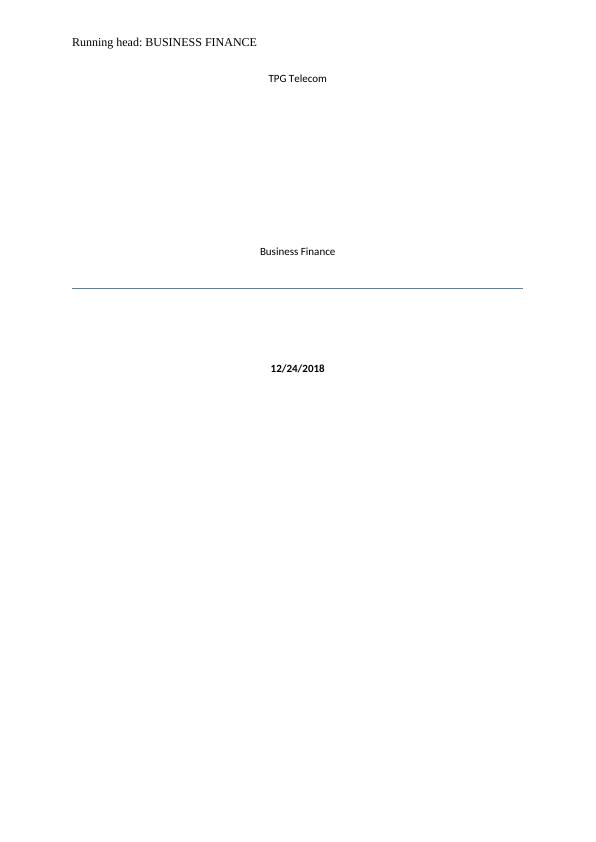
BUSINESS FINANCE 1
Table of Contents
Introduction................................................................................................................................2
Overview of TPG Telecom....................................................................................................2
Financial Market....................................................................................................................3
Types of Financial Market.................................................................................................4
Securities Trading Policy.......................................................................................................6
Operating and Financial Review............................................................................................6
Customer Growth...............................................................................................................6
Corporate Revenues...........................................................................................................7
Financial Results Review.......................................................................................................8
Revenue..............................................................................................................................8
Analysis of Cash Flow...........................................................................................................9
Free Cash flow...................................................................................................................9
Non –Operating Cash Flow..............................................................................................10
Balance Sheet.......................................................................................................................11
Debt..................................................................................................................................11
Cash and Cash Equivalents..............................................................................................11
Receivables and Payables................................................................................................12
Assets...............................................................................................................................12
Liabilities..........................................................................................................................12
Conclusion................................................................................................................................13
References................................................................................................................................14
Table of Contents
Introduction................................................................................................................................2
Overview of TPG Telecom....................................................................................................2
Financial Market....................................................................................................................3
Types of Financial Market.................................................................................................4
Securities Trading Policy.......................................................................................................6
Operating and Financial Review............................................................................................6
Customer Growth...............................................................................................................6
Corporate Revenues...........................................................................................................7
Financial Results Review.......................................................................................................8
Revenue..............................................................................................................................8
Analysis of Cash Flow...........................................................................................................9
Free Cash flow...................................................................................................................9
Non –Operating Cash Flow..............................................................................................10
Balance Sheet.......................................................................................................................11
Debt..................................................................................................................................11
Cash and Cash Equivalents..............................................................................................11
Receivables and Payables................................................................................................12
Assets...............................................................................................................................12
Liabilities..........................................................................................................................12
Conclusion................................................................................................................................13
References................................................................................................................................14
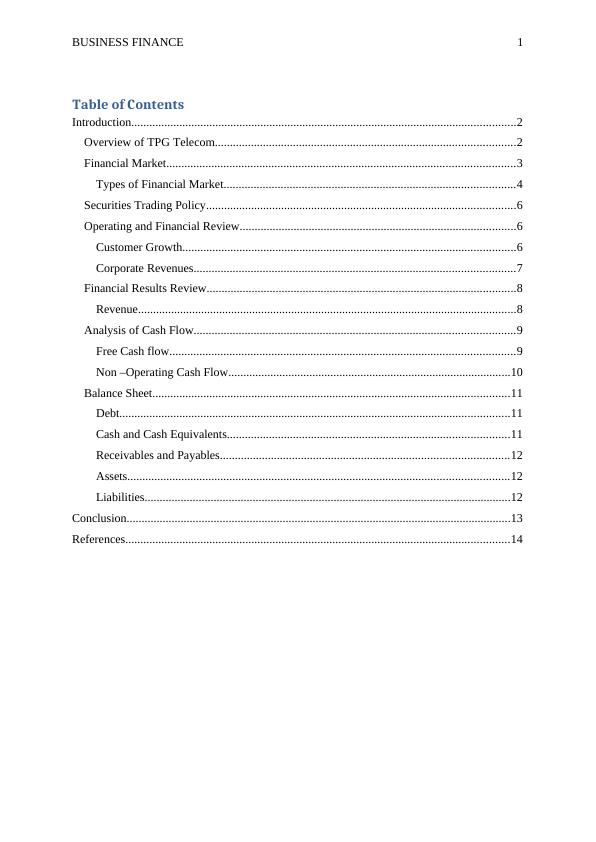
BUSINESS FINANCE 2
Introduction
Business finance is the money required to introduce and operate a business, which comprises
diversifying or modernizing operations and expansion. The business finance term comprises
the manner in which a firm uses and obtain money, frequently in terms of loans. In other
words, it is about strategies for investing, earning, and saving revenue. Business finance is
very essential for every firm to take on business and achieve success; a business needs
noteworthy investment to obtain new capital, inventory, or staff (Tracy and Tracy, 2011). In
the short-term, businesses need finance in the context of working capital in order to fulfil
operational expenses like raw materials, interest payments, remunerative payments,
inventory, etc. Correct financial for short-term and long-term and upkeep of good flow of
working capital is vital to retain the operations going. This is the duty of the business
managers to manage the investment and funds in the company such that they can be used at
the right time and place. All the situations are diverse, but smart managers take success cost
and their options for attaining financial growth (Borowski, 2010). The aim of this report is to
provide an overview of the financial position of TPG Telecom. The report will present
financial statements of TPG Telecom that will represent whether the financial position of the
company is strong or weak. Moreover, the different strategies used by the business to survive
and grow in the market will be elaborated into the report.
Overview of TPG Telecom
TPG Telecom Limited is an IT and Telecommunication Company of Australia that
specializes in business and consumer internet services along with mobile telephone services.
According to the reports of 2015, TPG Telecom is the second largest Australian internet
service provider and is the biggest virtual network operator. The company has around
360,000 mobile subscribers, 358,000 landline subscribers, and 671,000 ADSL2+ subscribers,
Introduction
Business finance is the money required to introduce and operate a business, which comprises
diversifying or modernizing operations and expansion. The business finance term comprises
the manner in which a firm uses and obtain money, frequently in terms of loans. In other
words, it is about strategies for investing, earning, and saving revenue. Business finance is
very essential for every firm to take on business and achieve success; a business needs
noteworthy investment to obtain new capital, inventory, or staff (Tracy and Tracy, 2011). In
the short-term, businesses need finance in the context of working capital in order to fulfil
operational expenses like raw materials, interest payments, remunerative payments,
inventory, etc. Correct financial for short-term and long-term and upkeep of good flow of
working capital is vital to retain the operations going. This is the duty of the business
managers to manage the investment and funds in the company such that they can be used at
the right time and place. All the situations are diverse, but smart managers take success cost
and their options for attaining financial growth (Borowski, 2010). The aim of this report is to
provide an overview of the financial position of TPG Telecom. The report will present
financial statements of TPG Telecom that will represent whether the financial position of the
company is strong or weak. Moreover, the different strategies used by the business to survive
and grow in the market will be elaborated into the report.
Overview of TPG Telecom
TPG Telecom Limited is an IT and Telecommunication Company of Australia that
specializes in business and consumer internet services along with mobile telephone services.
According to the reports of 2015, TPG Telecom is the second largest Australian internet
service provider and is the biggest virtual network operator. The company has around
360,000 mobile subscribers, 358,000 landline subscribers, and 671,000 ADSL2+ subscribers,

BUSINESS FINANCE 3
and possesses Australia’s second largest ADSL2+ network, involving of 391 ADSL2+
DSLAMs (TPG, 2018a). The company was established due to the merger between Total
Peripherals Group, which was introduced by Vicky Teoh, SP Telemedia, and David in 1986.
In 2018, Vodafone and TPG Hutchison Australia proclaimed their purpose to merge, with
49.9% stake of TPG in the merged company. TPG offer provides five varieties of services
and products comprising networking, accounting software, Internet access, mobile phone
service, and OEM services. In 1986, Total Peripherals Group was introduced by the
Australian businessperson i.e. David Teoh. The group was introduced as IT Company that
vends OEM computers and later shifted towards offering mobile telephone services and
internet services. In 2007, TPG tool 70% controlling interest of internet provider Chariot
(TPG, 2018c).
TPG Telecom concentrates on middle-market buyout and growth equity opportunities. The
company has adopted a hands-on approach to partnership, in order to recognize the exclusive
businesses all over Africa, Asia, U.S., and Europe and support in attaining full potential. The
business can assist at every stage of the growth of the company, with the help its international
expansion. The company is also focusing on meeting its corporate social responsibilities by
organizing numerous events for families with gifted students. The company is striving
towards enhancing and increasing the learning and education opportunities if the talented and
gifted students (TPG, 2018b).
Financial Market
A financial market is a comprehensive term recitation any market where buyers and sellers
contribute to the trade of assets like currencies, derivatives, equities, and bonds. Financial
markets are classically distinct by possessing clear pricing, basic guidelines on trading, fees
and costs, and market services defining the security prices that trade (Valdez and Molyneux,
2010). Financial markets are available in all the countries of the world. Few of them are
and possesses Australia’s second largest ADSL2+ network, involving of 391 ADSL2+
DSLAMs (TPG, 2018a). The company was established due to the merger between Total
Peripherals Group, which was introduced by Vicky Teoh, SP Telemedia, and David in 1986.
In 2018, Vodafone and TPG Hutchison Australia proclaimed their purpose to merge, with
49.9% stake of TPG in the merged company. TPG offer provides five varieties of services
and products comprising networking, accounting software, Internet access, mobile phone
service, and OEM services. In 1986, Total Peripherals Group was introduced by the
Australian businessperson i.e. David Teoh. The group was introduced as IT Company that
vends OEM computers and later shifted towards offering mobile telephone services and
internet services. In 2007, TPG tool 70% controlling interest of internet provider Chariot
(TPG, 2018c).
TPG Telecom concentrates on middle-market buyout and growth equity opportunities. The
company has adopted a hands-on approach to partnership, in order to recognize the exclusive
businesses all over Africa, Asia, U.S., and Europe and support in attaining full potential. The
business can assist at every stage of the growth of the company, with the help its international
expansion. The company is also focusing on meeting its corporate social responsibilities by
organizing numerous events for families with gifted students. The company is striving
towards enhancing and increasing the learning and education opportunities if the talented and
gifted students (TPG, 2018b).
Financial Market
A financial market is a comprehensive term recitation any market where buyers and sellers
contribute to the trade of assets like currencies, derivatives, equities, and bonds. Financial
markets are classically distinct by possessing clear pricing, basic guidelines on trading, fees
and costs, and market services defining the security prices that trade (Valdez and Molyneux,
2010). Financial markets are available in all the countries of the world. Few of them are
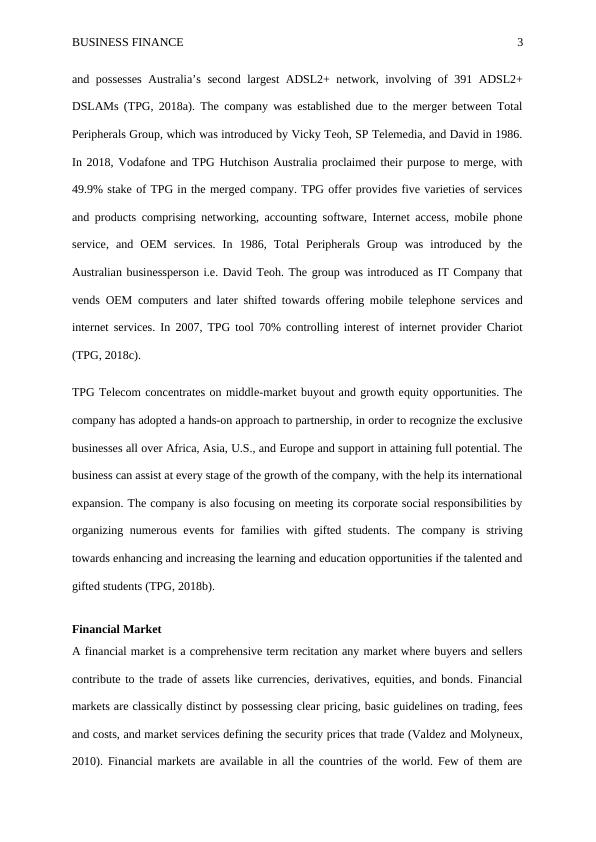
BUSINESS FINANCE 4
small, with a limited number of participants, whereas others such as Forex markets and New
York Stock Exchange (NYSE) are involved in the trading of trillions of dollars every day.
Types of Financial Market
Capital Markets
In the capital market, institutions and individuals trade their financial securities. Institutions
and organizations from the private and public sectors also frequently vend securities in this
market to raise funds. Therefore, this kind of market is created of both the secondary and
primary markets. There are two types of market in the capital market i.e. Stock market and
bond market (Goyal and Goyal, 2014).
Stock Market
In Stock markets, stockholders are permitted to buy and sell their shares in the publicly traded
businesses. These are the essential market economy area because they offer business as
access to investors and capital with a share of ownership with the business and the possibility
of gains depending on the future performance of the company (Campbell, Lo and MacKinlay,
2012).
Bond Markets
A bond is commonly known as a debt investment under which an investor advances money to
a business that can be governmental or corporate. This business takes funds for the prescribed
time duration at a fixed rate of interest. Different businesses, states, U.S. and a foreign
government, and municipalities utilize bonds in order to finance a range of activities and
projects (Madura, 2016).
Money Market
The money market is the financial market segment under which trading of financial
instruments with great liquidity and short maturities take place. Participants use the money
small, with a limited number of participants, whereas others such as Forex markets and New
York Stock Exchange (NYSE) are involved in the trading of trillions of dollars every day.
Types of Financial Market
Capital Markets
In the capital market, institutions and individuals trade their financial securities. Institutions
and organizations from the private and public sectors also frequently vend securities in this
market to raise funds. Therefore, this kind of market is created of both the secondary and
primary markets. There are two types of market in the capital market i.e. Stock market and
bond market (Goyal and Goyal, 2014).
Stock Market
In Stock markets, stockholders are permitted to buy and sell their shares in the publicly traded
businesses. These are the essential market economy area because they offer business as
access to investors and capital with a share of ownership with the business and the possibility
of gains depending on the future performance of the company (Campbell, Lo and MacKinlay,
2012).
Bond Markets
A bond is commonly known as a debt investment under which an investor advances money to
a business that can be governmental or corporate. This business takes funds for the prescribed
time duration at a fixed rate of interest. Different businesses, states, U.S. and a foreign
government, and municipalities utilize bonds in order to finance a range of activities and
projects (Madura, 2016).
Money Market
The money market is the financial market segment under which trading of financial
instruments with great liquidity and short maturities take place. Participants use the money
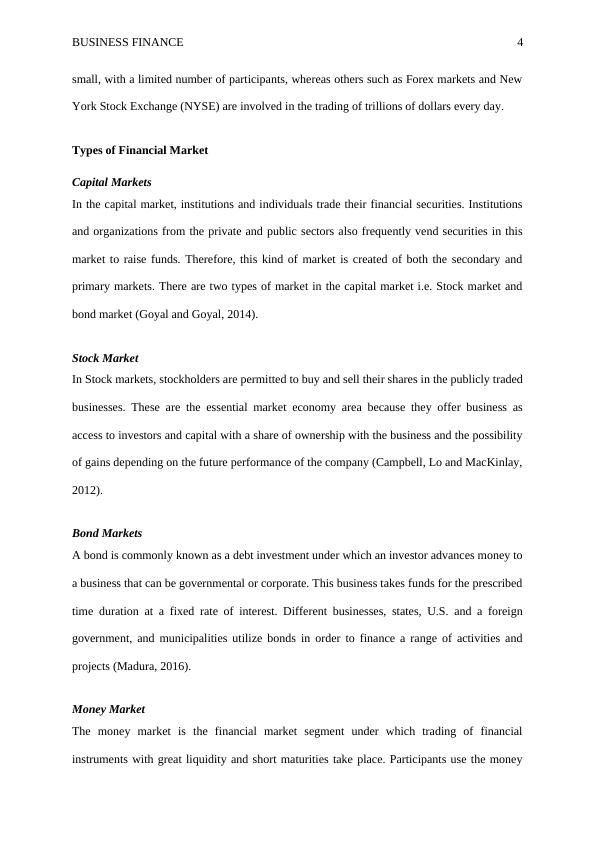
BUSINESS FINANCE 5
market for lending and borrowing in the short run, from numerous days in a year. Securities
of money market comprised of banker’s acceptance, municipal notes, negotiable certificates
of deposit (CDs), repurchase agreement, federal funds, U.S. Treasury bills, Eurodollars, and
commercial paper (Burton, 2010).
Spot or Cash Market
Capitalizing in the cash market is extremely cultured, as it possesses opportunities for both
big gains and big losses. Under the cash market, products are vended for cash and are
delivered directly.
Derivatives Markets
The derivative is the name selected for this market because the value is derived from its
original assets. A derivative is an agreement and the price of the contract is dogged by the
core asset price in the market (Levinson, 2018).
Primary and Secondary Market
New securities are issued in the primary market on an exchange. Businesses, government,
and other different groups attain financing with the help of equity or debt based securities.
Primary markets are also called as "new issue markets," are enabled by guaranteeing groups,
which contain investment brands that will arrange a beginning range of the price for a
oversee security and then supervise its transaction straight to investors.
The market where investors buy assets or securities from a different investor is known as a
secondary market. The SEC or Securities and Exchange Commission records securities
preceding to their initial issuance, then they initiate trading in the market such as Nasdaq,
New York Stock Exchange, or other different stock exchange where the assets and securities
have been putative for trading and listing (Talmor and Vasvari, 2011).
market for lending and borrowing in the short run, from numerous days in a year. Securities
of money market comprised of banker’s acceptance, municipal notes, negotiable certificates
of deposit (CDs), repurchase agreement, federal funds, U.S. Treasury bills, Eurodollars, and
commercial paper (Burton, 2010).
Spot or Cash Market
Capitalizing in the cash market is extremely cultured, as it possesses opportunities for both
big gains and big losses. Under the cash market, products are vended for cash and are
delivered directly.
Derivatives Markets
The derivative is the name selected for this market because the value is derived from its
original assets. A derivative is an agreement and the price of the contract is dogged by the
core asset price in the market (Levinson, 2018).
Primary and Secondary Market
New securities are issued in the primary market on an exchange. Businesses, government,
and other different groups attain financing with the help of equity or debt based securities.
Primary markets are also called as "new issue markets," are enabled by guaranteeing groups,
which contain investment brands that will arrange a beginning range of the price for a
oversee security and then supervise its transaction straight to investors.
The market where investors buy assets or securities from a different investor is known as a
secondary market. The SEC or Securities and Exchange Commission records securities
preceding to their initial issuance, then they initiate trading in the market such as Nasdaq,
New York Stock Exchange, or other different stock exchange where the assets and securities
have been putative for trading and listing (Talmor and Vasvari, 2011).
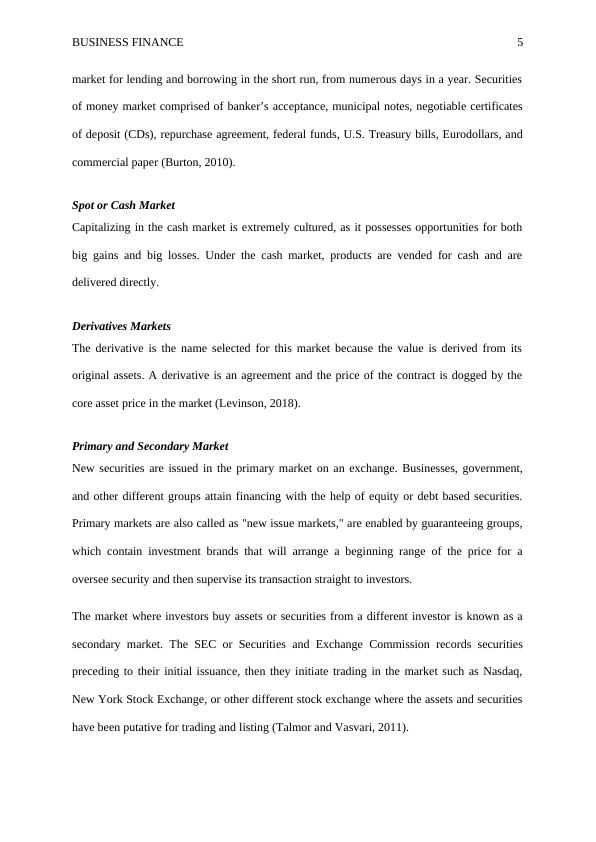
End of preview
Want to access all the pages? Upload your documents or become a member.
Related Documents
Finance for Business - Assignment Samplelg...
|19
|3927
|80
Auditing and Ethicslg...
|12
|2697
|1
Financial Accounting Assignment: Analysis of TPG Telecom and Telstra Corporationlg...
|24
|3736
|353
Comparative Financial Analysis of Telstra Corporation Limited and TPG Telecom Limitedlg...
|17
|3474
|399
Investment Opportunity in Australian Market: Telstra Corporation Limited and TPG Telecom Limitedlg...
|18
|4645
|194
Corporate Accounting: Financial Statements Analysis of Telstra and TPG Telecom Limitedlg...
|27
|5087
|482
